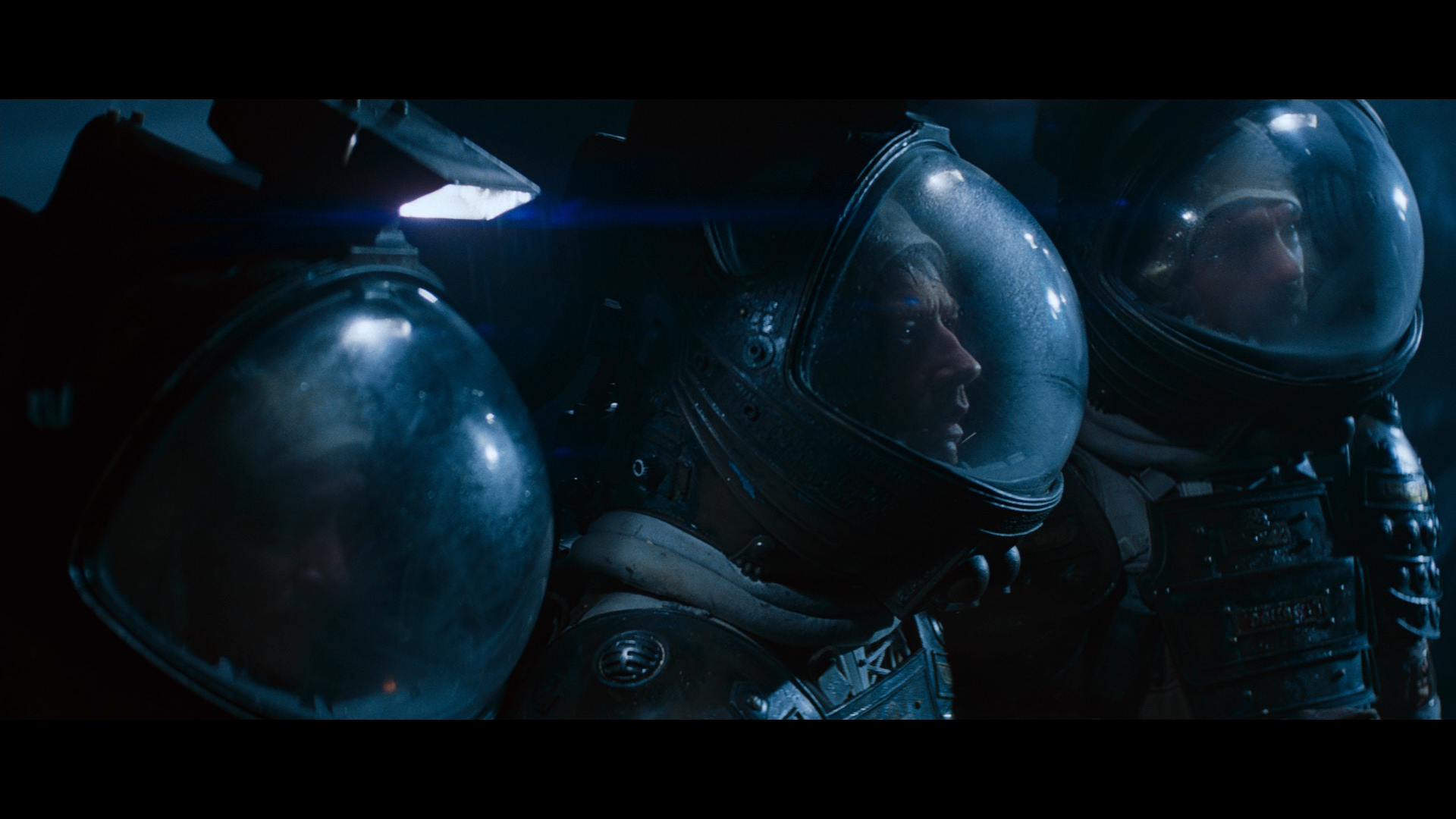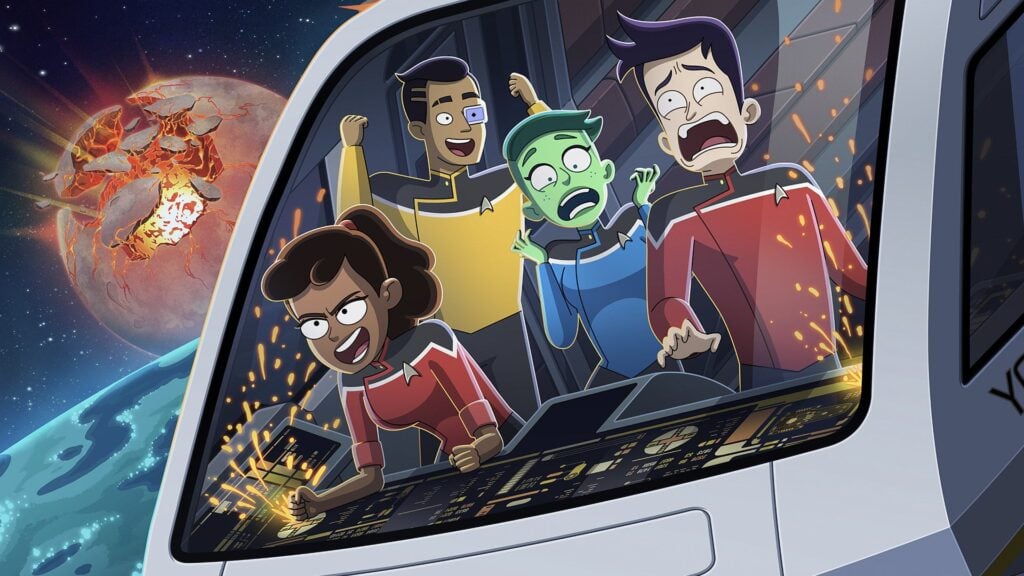The perfect movie about ‘a perfect organism’, Alien is a one of cinema’s finest example of ‘B’ movie subjects elevated to ‘A’ movie masterclass status by a gifted director during his most formative and incredible period in cinema. Celebrating its 40th Anniversary, Fox’s 4K UHD release of this classic film is a revelation – It cannot have ever looked this magnificent.
The Production: 5/5
“You still don’t understand what you’re dealing with, do you? The perfect organism. Its structural perfection is matched only by its hostility.”
The Commercial Towing Vehicle Nostromo, with her crew of seven, are pulled out of hyper sleep on their journey home with orders to investigate a transmission of unknown origin. What they discover proves to be deadly.
That’s a lean description for Alien, but a compliment to how the leanest of plots can, through incredible artistry, writing and performance, become something quite extraordinary- which Alien has. This brilliant film is a slow descent into fear and panic, unraveling a fragile crew into their dominant impulses, from the curious to the frightened, and from the angry to the reluctant. At its heart, it’s a showcase of a brutal cat-and-mouse premise in a science-fiction version of a haunted house. At first glance, Alien is a creature-feature, but it is really something much more entirely; a science fiction horror without peer. A flawless marriage of sound and image and performance and efficiency of direction. There isn’t a single thing of waste in this film. Not a single shot or line of dialogue, and the claustrophobic setting and premise delivers a frightening experience.
Dan O’Bannon and Ronald Shusett’s story, with screenplay by Bannon, was always a taut creature feature with more depth of ideas than the typical feature of its ilk. The characters created, as filmed and performed, have become quintessential representations of the blue-collar workers in a gritty, grimy future. Much like how director James Cameron’s team of Colonial Marine’s in the follow-up Aliens have become the oft-copied, but never repeated perfect example of a well-armed but outmatched bunch of soldiers fighting something more than human, the crew of the Nostromo are a fascinating collection of relatable, every day people. However, as strong as O’Bannon and Shusett’s original material was, the entire production was elevated to iconic heights the moment Ridley Scott signed on to direct. Scott, who had a handful of shorts and TV episodes under his belt, plus his first feature film in The Duellists, was better known in the industry for his work in the field of commercials. Once aboard Alien, he gave a full expression of his artistry, bringing an elegance to every moment, from the opening as the camera moves through the ship’s halls, to the terrifying climax. His framing is visual poetry, and he finds time to explore, or enjoy, moments where others might have rushed things. A fine example is the pageantry the film shows for the ship-to-surface travel sequence. It’s a such a beautifully shot film, you could freeze-frame any moment and find an image worthy of framing. For all it’s grit, grime, shadows and cramped quarters, it’s gorgeous.
The look of the film is supported by sets that are a marvel of design and gothic mood. Incredible creations, from the hallways of the Nostromo to the magnificent interior of the Derelict, and the mysterious, monstrous creation of the Space Jockey. It’s legendary stuff. Production Designer Michael Seymour, Concept Artist Ron Cobb, Art Directors Roger Christian (who had enormous influence on the end results of what we see) and Leslie Dilley, along with Cinematographer Derek Vanlint, conspire to deliver frightening cinematic wonders. Under director Scott, they partner to build out confined, dark and beautiful spaces, lit to perfection, and the kind of film you can study (as I did in Film Studies at college) for the art and craft of mise en scene.
With its cast, Alien importantly does three things. The first was to match seven principle characters with the absolute best performer (more about the stellar cast below). The second was to boldly surprise us with who is killed so early (something Alien3 would try to repeat). The third, and most important, was the creation of Ripley, a female character imbued with the strength and resolve and become the film’s hero by the time the credits roll. The importance of Ripley would be famously cemented in cinema in the sequel, but key expectations were subverted with Alien, an important milestone.
Sigourney Weaver brings to Ripley a certitude that appear to cover for vulnerabilities. It was her landmark role and one she would revisit three more times, and in each successive film, evolve her portrayal in intriguing ways – often despite the quality of the film she was playing her. Tom Skerrit as Captain Dallas is one of the film’s triumphs for how he delivers a reluctant and grumpy man. Skerrit’s Dallas is a weary, absent leader, in command but aggravated by the demands of command. By contrast, Weaver’s Ripley is eager and frustrated by the lack of command authority. Yaphet Koto’s Parker and Harry Dean Stanton’s Brett, the lower-level workers charged with mechanical maintenance give the film it’s lightest moments as they express their frustrations at rank and station, with Parker being astute and forthright, and Brett seeming more like Parker’s sidekick. Veronica Cartwright’s frayed performance as Lambert – unable to deal with the pressures of their dire circumstance, is compelling, while John Hurt’s curious and calm Kane, the first to have a run in with the alien threat, is on screen for the least amount of time but creates a lasting impression (in no small part to his famous scene around the dinner table). Ian Holm’s Ash, detached and distant with a penchant for precision and emotional emptiness, is superb. The nature Ash’s character turns out to have been not only a brilliant and unexpected twist in the film, but the source of fascinating things in future sequels and prequels.
Finally, special mention to Bolaji Badejo, the performer who gave life to the fully-grown alien. His movements, stalking and sly, were something potent. Besides the outstanding work of Doug Jones (Pan’s Labyrinth, Star Trek: Discovery), Badejo has the distinction of delivering a creature performance more than worthy of the sublime design.
As a special effects and creature effects film, Alien is resplendent. The model work is exceptional, but the legend of this film is the use, and realization, of H.R. Giger’s perfect organism. With its unique lifecycle and fascinatingly different designs during the multiple stages, from egg to fully realized xenomorph (as they would be coined in the sequel), Giger gave cinema things we’d never seen. There are books out there, including Paul Scanlon and Michael Gross’ The Book of Alien, that showcase some of the earlier design concepts for the alien prior to Giger coming aboard the project, and it supports just how critical Giger’s involvement was to the success of the film. The Swiss artist was hired in part due to his compendium of images published in 1977’s Necronomicon, and his unique style of biomechanics was an inspired design choice to blend with the Alien film’s environments and plot. The creature design, for which Giger would win an Oscar, and the exterior and interior of the Derelict, would cement Giger as a visionary artist with global recognition and was an undeniably integral ingredient for the production.
The final, critical element to Alien’s perfection is Jerry Goldsmith’s score, which features some of the finest examples of bold orchestral experimentation in cinema. Along with Chinatown and Star Trek – The Motion Picture, Alien is a serious contender for the genius composer’s greatest creation. Here, Goldsmith employs a discordant listen for most ears, and there’s a haunting quality to the unusual sounds and musical cadences, preceded by an eerie, yet romantic opening cue that at once augers discovery and dread. Goldsmith wrote a two-tone repeat for the first sequence inside the ship as the camera pans through the hallways to the hyper sleep chambers, which, following the romanticized opening theme, further lull us into a sense of vulnerability and innocence. As the film progresses, Goldsmith finds fascinating sounds to create a real sense of alien and ‘other’ atmospheres, including echoplex marimba and steel drums, serpent (a snake-like instrument), Indian conch and didgeridoo. It’s a magnificent achievement. Goldsmith’s experience working on Alien was, according to interviews with the composer, a miserable experience. Portions of his score were replaced with cues from his earlier scores (Freud features in several key moments), and his original composition for the finale with Ripley and the Alien in the Narcissus lifeboat was truncated to just 20 or so seconds, and replaced with Howard Hanson’s “Symphony No. 2 (The Romantic).” Despite the disagreements, the result is a sublime and important melding of aural and visual mastery.
Alien and its sequel, Aliens, are number two and one of my all-time favorite films respectively. Besides watching them in the formative years of my life, their achievements are in that rarified space of cinema reserved for movies that elevate the very craft they explore. Alien has earned its place as one of cinema’s finest accomplishments and if you doubt that statement, you have but to watch the film and be reminded of why.
Video: 5/5
3D Rating: NA
Alien was one of the first movies I purchased new on VHS back in the day. It was one of the first films I purchased in the UK as part of Fox’s widescreen VHS collection (Aliens, The Abyss were two of the others). The DVD was picked up the day it was released, and I thought the film had seen its best days as part of the Quadrilogy Blu-ray release (I ordered the Alien Egg version from the Fox booth at 2012’s Comic-Con), but this UHD release is like watching the film with a new pair of eyes. It’s is not just remarkable; it is one of the best-looking discs I have ever seen.
There is a level of detail that will astonish even the most ardent fans of this film. A richness to the infrequent bursts of color among the grey and dreary halls of the Nostromo (orange, deep red piping and the like). The white of the hyper sleep chamber is bright and impressive, and the level of fine shadow detail and impossibly deep blacks are mesmerizing.
The layer of HDR improves color saturation noticeably and some scenes with dominant color, like the inside of ‘Mother’, are richer versions of the muted yellow. I can’t be certain if these stronger color hues are closer to the original negative, or expressions possible from the HDR choices applied to the 4K restoration (which was supervised by Ridley Scott and Pam Dery). The countless times I have seen this through the years, on numerous formats, no two presentations have been 100% alike. As such, this release isn’t just an increase in definition and clarity (with film grain appropriate, and more apparent in the lower lit sections), but also a version with variations on the color balance that appear their truest to my eyes, but I can’t know that for certain having never seen the film projected in a perfectly calibrated movie theater.
I should also note that the Director’s cut available on this UHD release integrates the additional footage which isn’t 4K native. If you don’t have the original theatrical film committed to memory (as I do), you may miss where the Director’s Cut insertions are, but you may also recognize them for their marginally lesser ‘pop.’
Audio: 5/5
The audio remains the same as used in the previous Anthology/Quadrilogy releases. Here’s what Matt Hough had to say about the audio in his 2016 review of that disc:
“The DTS-HD Master Audio 5.1 sound mix will likely surprise you with its depth, spread, and clarity. The LFE channel gets a wonderful workout with deep bass effects constantly at play, and the sound field is alive with split sounds and directionalized dialogue coming from the various available channels. Jerry Goldsmith’s miraculous score is likewise filtered through the entire sound field to amazing effect.”
This release also features as DTS-HD Master Audio 4.1 track on the Theatrical Version as well, recreating the original theatrical experience.
Special Features: 3/5
As with the audio, the special features are a repeat of what was previously included on the Anthology Blu-ray release (though not the more extensive special features available for the Quadrilogy release), with a Digital Copy of the movie redeemable as well.
Here’s Matt’s summary of the special features from his earlier review:
• Both the 1979 and 2003 cuts of the movie are presented. The 2003 version contains an introduction by Ridley Scott.
• The 1979 version contains an audio commentary by Ridley Scott. The 2003 cut contains an edited commentary featuring Scott, writer Dan O’Bannon, producer Ronald Shusett, editor Terry Rawlings, and stars Sigourney Weaver, Tom Skerritt, Veronica Cartwright, Harry Dean Stanton, and John Hurt. Both are must-listens for the information provided on the making of the film and for aspects of the production which the cast and crew found fun, disturbing, irritating, or laudatory.
• Two isolated scores by Jerry Goldsmith are available for listening: the final theatrical score and the original score may each be chosen from the main menu.
• There are seven deleted scenes which may be viewed individually or in a 6 ¾-minute group. They’re in 1080p.
Overall: 5/5
One of my favorite scenes in all of cinema, largely for how it affected me as a young film fan, is where Harry Dean Stanton’s Brett must go find the cat, Jonesy. Along with Parker and Ripley, Brett was tracking what they thought was the small creature through the bowels of the ship using a motion tracker (the creature had recently ‘burst’ into the world). The three characters had tracked what they thought was the creature, but it was the cat. Brett, realizing it was a feline friend, let him go. A mistake, as Parker points out, because they could find themselves mistaking the cat for the creature again. Brett is sent off to grab Jonesy while Parker and Ripley continue their tracking. The majesty of the film’s sets, lighting, attention to extraordinary detail, and advancement of the story and terror, are encapsulated in the few minutes that follow. The sets expand the terrain of the ship and add height to the world. Stanton’s nervous and slow pursuit of the cat is a quiet character study, and the culmination of the sequence, featuring a reveal of the full-grown Alien, is a moment oft-borrowed in cinema. Add in Goldsmith’s deft and discordant musical touches toward the end of the sequence, and the moment is pure perfection.
Alien is something very special in cinema and Fox’s release is splendid. Very highly recommended!
https://smile.amazon.com/Alien-40th-Anniversary-Blu-ray/dp/B07P83ZXX4/ref=sr_1_1?crid=141M7DLNON78S&keywords=alien+4k&qid=1556489175&s=gateway&sprefix=Alien%2Caps%2C142&sr=8-1Post Disclaimer
Some of our content may contain marketing links, which means we will receive a commission for purchases made via those links. In our editorial content, these affiliate links appear automatically, and our editorial teams are not influenced by our affiliate partnerships. We work with several providers (currently Skimlinks and Amazon) to manage our affiliate relationships. You can find out more about their services by visiting their sites.





Similar threads
- Neil Middlemiss
- Blu-ray and UHD
2 Tags 20th century fox 4k blu-ray disney uhd review- Robert Harris
- Blu-ray and UHD
29 30 31- Todd Erwin
- Blu-ray and UHD
2 3